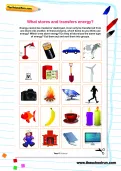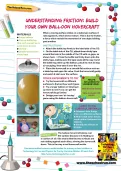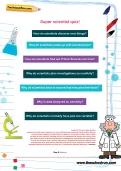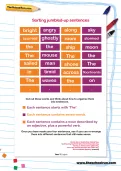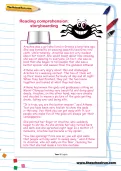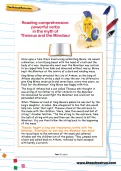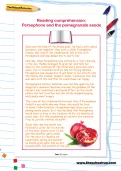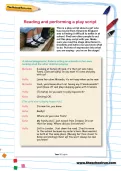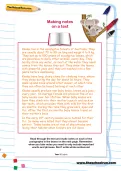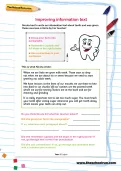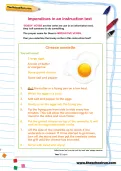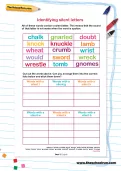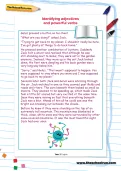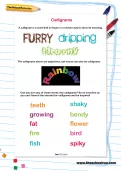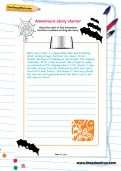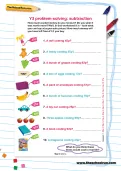Cut out these words and think about how to organise them into sentences. Each sentence starts with ‘The’. Each sentence contains seven words. Each sentence contains a noun described by an adjective, plus a powerful verb. Once you have made your four sentences, see if you can re-arrange them into different sentences that still make sense.
or
Register to add to your saved resources
Already a subscriber? to view this content.
Read this story about ‘Arachne the Spinner’. Can you complete a storyboard? Draw a picture to show what is happening in each part of the story and write a short sentence underneath to explain it.
or
Register to add to your saved resources
Already a subscriber? to view this content.
This reading comprehension PDF worksheet was created by a primary school teacher to support KS2 literacy and help Year 2 children develop their reading skills.
Read this story about the myth of Theseus and the Minotaur. Look at the part of the story in bold. The fight between Theseus and the Minotaur is not described in detail. Can you write a paragraph explaining what happened?
or
Register to add to your saved resources
Read this conversation between Hades and Persephone when he takes her to the Underworld. Persephone wants to leave, but Hades is trying to persuade her she will be happy with him. Think about what Persephone and Hades might have said to each other and then write the conversation between them. Don’t forget the rules of speech: 1. Start each character’s speech on a new line. 2. Use “ to open the speech. 3. End the speech with !, ? or ,. 4. Use ” to close the speech. 5. Use a reporting clause (for example, said Hades or whispered Persephone)
or
Register to add to your saved resources
Already a subscriber? to view this content.
This is a play script about a girl who has moved from Ireland to England and is finding it difficult to settle in at school. Find two other people to act out this play script with you. Make sure you read the stage directions (in brackets and italics) so you know what to do. Put lots of expression into what you are saying – you’re on the stage!
or
Register to add to your saved resources
Already a subscriber? to view this content.
Paragraphs are sections of writing. In information texts, writers try to make sure that each thing they are writing about is separated into paragraphs. How would you split up this text about Chinese New Year into different paragraphs? Make a mark on the text to show where each new paragraph would start.
or
Register to add to your saved resources
Already a subscriber? to view this content.
Cut out all the word cards on these two pages. Can you match each noun (white cards) with two adjectives (coloured cards)? There is no one correct way to do this, but your two adjectives must make sense with the noun you have chosen.
or
Register to add to your saved resources
Already a subscriber? to view this content.
Read through the text and make notes on each of the paragraphs in the boxes on the next page. Remember: when you take notes you need to only include important words and phrases. Don’t write whole sentences!
or
Register to add to your saved resources
Already a subscriber? to view this content.
Nicola had to write an information text about teeth and was given these success criteria by her teacher: Group your facts into paragraphs; remember capitals and full stops in the right places; use connectives in your sentences. Did Nicola do what the teacher asked?
or
Register to add to your saved resources
Already a subscriber? to view this content.
‘Bossy’ verbs are the verbs we use in an information text; they tell someone to do something. The proper name for them is imperative verbs. Can you underline the bossy verbs in this instruction text?
or
Register to add to your saved resources
Already a subscriber? to view this content.
All of these words contain a silent letter. This means that the sound of that letter is not made when the word is spoken. Cut out the words above. Can you arrange them into the correct lists below and stick them down?
or
Register to add to your saved resources
A Year 3 English worksheet created by a primary school teacher to help your child understand and identify adjectives and verbs.
Read this adventure story. Can you identify the adjectives and powerful verbs that the author has used to make this piece of writing interesting to the reader?
or
Register to add to your saved resources
Already a subscriber? to view this content.
Jake is in a dilemma! Read the beginning of this story. What would you do if you were in Jake’s position? Continue writing and describe what happens next.
or
Register to add to your saved resources
Already a subscriber? to view this content.
Emma had to describe a Victorian classroom and was given these success criteria by her teacher: remember to add adjectives; use capitals and full stops in the
right places; describe what you can see, hear, smell and feel. Has Emma done what her teacher asked?
or
Register to add to your saved resources
Practise adding punctuation to a letter, including capital letters and full stops, exclamation marks, question marks and commas with this teacher-made worksheet.
Maisie has written a letter to her favourite author, but she has forgotten all the punctuation! Can you go through her letter and add in capital letters and full stops? You may also need to include some exclamation marks, question marks and commas.
or
Register to add to your saved resources
Already a subscriber? to view this content.
Think of two books you have read, both written by the same author. Can you compare them? Write a short description of the plot of each book. Give three examples of how the books are different. Which book did you prefer? Why? Give three reasons why you enjoyed it more.
or
Register to add to your saved resources
Already a subscriber? to view this content.
Can you turn any of these words into calligrams? Be as inventive as you can! Search the internet for calligrams and be inspired!
or
Register to add to your saved resources
Already a subscriber? to view this content.
Can you find the following features in this newspaper article? Headline, caption, paragraphs, picture.
or
Register to add to your saved resources
Mary was in bed, in a deep sleep. She was dreaming about eating a huge, delicious ice-cream. In her dream, she heard a tapping on the window. The tapping continued. After a few seconds, Mary began to wake up and realised the tapping wasn’t in her dream... What do you think happens next? Continue writing the story.
or
Register to add to your saved resources
Already a subscriber? to view this content.
Use your subtraction skills to answer these questions. How quickly can you finish them all?
or
Register to add to your saved resources
Already a subscriber? to view this content.
